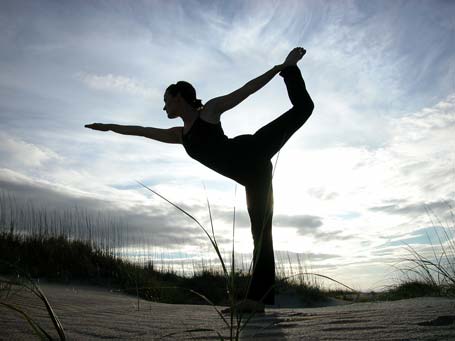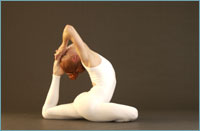yoga
Health as Purity of body, mind and soul, which has become so dark because of negative thoughts and actions and it is here Yoga that comes in handy to treat this state of mankind. With its regular practice one is able to eradicate all the impurities both in mind and body and regulate the self towards GOD.
According to the ancient hindu philosophy, Yoga is the union of body and mind which helps one to attain oneness with the “Supreme Being”, the ultimate aim of our birth.
Regular yogic practice helps to acquire a balanced body and mind which naturally trains him to be in present moment and with a minimum input of energy/time, he can achieve a maximum output of work. Is it not a greater benefit in this fast pace world where one lacks time.
Yoga is a combination of asanas (postures), pranayama (breathing techniques) and dhyana (meditation). Its benefits can be cited as below :
At Physical Level –
Provides strength and flexibility, body awareness and energy level increases, heals the injuries very quickly, helps to fight the pain caused by various ailments, immunity increases, blood circulation to brain, digestive system and skin is increased, skin glows, aids in the overall efficient functioning of the internal organs. Gives relief from the muscular pain , open constricted air passages, aging process is delayed, toxins in the body are flushed out.
It is also highly therapeutic ie.. it treats various ailments like digestive disorders, headaches, irritable bowel syndrome, asthma, skin problem, nervous tension etc, thyroid function is improved hence the weight is controlled, knee cartilage is made strong, it helps to fight pain of arthritis and rheumatism, leg muscles are toned up, flexibility of spine is increased, also controls autonomic or involuntary functions, such as temperature, heartbeat and blood pressure.
At Mental Level –
Helps one to let go of emotional blockages and negativity hence – helps to lead a relaxed state of living, helps one to face the stressed situation more enthusiastically, provides strength to fight depression, frustration and anxiety, you feel that you are in control of your own self, you are able to look life always on its positive side, you will have an internal harmony and a great sense of balance.
Also concentration increases, provides courage and a hopefulness, creates a consistent sense of well being, brings harmony in relationship, deals with mood swings, intellect develops, regulates all the senses, will power increases, increases mental clarity, gives a peace of mind.
At Spiritual Level –
It helps one to realize that you are more than this body and mind and helps in awakening the divinity, it also enhance the movements of energy through ajna (the centre of intuition). helps the soul to flourish and helps to understand his true nature.
It also softens the rough edges in our character and dissolves the solid crust of your heart region which is important in our ultimate journey towards the ultimate God.
Golf is more of a hole-in-one, instead of taking many shots to get an intended result. I meant this in as an analogy, not a statement on your golf game, though yoga could certainly help.
By balancing the body, feelings, and thoughts, you are therefore becoming more conscious. You make better choices and have an overall greater awareness. The daily practice of yoga seems to cultivate awareness within the body, for starters. You can learn to choose consciously and live peacefully with the choice.
Yoga is a process for achieving this balance, which ultimately enables us to control our minds. Called raja (or astanga) yoga, this process includes 8 steps.
Morality — Steps 1 and 2
Steps 1 and 2 are akin to the Ten Commandments. They are a code of conduct. You do not have to achieve all this stuff before you can start practicing yoga. As you become more interested in yoga, your vices may begin to seem unnecessary. It is, however, a good idea to be open-minded.
- Step 1: Don’t injure, lie, steal, be indiscriminate with your vital energies (sexual, emotional, etc.), or be greedy.
- Step 2: Do be clean inside and out, content, self-controlled, disciplined, and devoted. This step is about developing a regular practice.
External Processes — Steps 3, 4 and 5
- Step 3: This step, called asana, refers to posture, and the yoga literature generally describes it as a comfortable seated position suitable for meditation. Asana is usually what we learn in a yoga class, and it has evolved into much more than sitting. There are thousands of different physical positions used in yoga, ranging from just sitting quietly to complicated contortions that are fun to watch and nearly impossible to execute. Most standard yoga postures are achievable to some extent by the average person, and they are extremely beneficial. Many people who practice them experience increased flexibility, strength, stamina and balance. Remember the three aspects of ourselves (physical, emotional, mental) we want to develop? Asana is an excellent method of exercise for the physical, emotional and mental aspects of ourselves.
There are many different flavors of asana (yoga poses). One type uses props such as wooden blocks and straps to create very precise body alignment. Another favors a routine performed in a very hot room to induce sweating. Some classes are slow and calming, others are very vigorous and may include jumping. Proponents of a particular style are not above proclaiming their version of asana as the one true yoga. Your one true yoga is the one that works for you. Listen to the guru within as you sample styles and teachers of yoga. - Step 4: Breath control is central to yoga. The breath and the emotions are very connected. For example, if we feel angry, the breath is rapid and shallow. If we feel calm, the breath is deep and slow. Yogic breathing techniques can modify the practitioner’s emotional state. Because the breath can affect the emotions so profoundly, it is best to have guidance when practicing breathing techniques.
- Step 5: Withdrawal of the senses: At this stage, external stimuli begin to lose their effect.
Internal Processes — Steps 6, 7 and 8
- Step 6: Concentration: At this level we start approaching mental focus. If you can focus on one thing for twelve seconds straight, you are concentrating. Many people begin by observing the breath. During these internal processes, thoughts or emotions may drift into awareness. These may become frustrating distractions; however, such thoughts and emotions should not be suppressed. Rather, they should be observed in a detached manner, and the attention should be gently guided back to the breath or other object of focus. At first, the entire practice of concentration may consist of redirecting the attention. Gradually, the distractions will become fewer and farther between. This practice will help reduce the non-productive mental activity during waking consciousness and is an important aspect of gaining mental control.
- Step 7: Meditation: Meditation is unimpeded concentration for at least 144 seconds. During meditation, you actually become connected to the object of focus.
- Step 8: Samadhi (pure consciousness): Samadhi is complete and total merging with the object of your meditation. It is described as a supremely blissful state.
So I might want to try Yoga. Now What?
Obviously, the only thing between YOU and enlightenment is taking that first class (And the second, and the third!) It’s usually a good idea to sample several classes until you find one that feels right, both during and after class. Do ask questions – a good yoga teacher will welcome them.
Whichever path you choose, remember that the purpose of all yoga is union of body, feelings and thoughts. In that oneness lies our freedom.
The Purpose of Yoga – Aging Gracefully
Most Yoga practitioners, and teachers, begin to realize the anti-aging benefits of Hatha Yoga, within a short time. However, with all of the anti-aging scams in abundance today, most Yoga teachers hesitate to utter the words “anti” and “aging” in the same sentence.
The many benefits of steady Yoga practice, to all age groups, are enhanced, when we explore the physical limits of our bodies. There are times when we surprise ourselves with what we can, and what we cannot, do.
The more experienced students usually do not take risks. They have “been there and done that.” New Yoga students are warned not to force, while they learn their physical limits.
Have you ever heard the saying, “Youth is wasted on the young?” When I first heard it, I was quite young, and the words were shouted at me by a man who was about the age of my Grandfather.
Unfortunately, I took offense because of his tone, and I did not understand his message. My reaction was silence, because of his age; he deserved respect, and I did respect him, completely.
In my mind, I thought, “I’m not wasting my youth.” I really did not understand. His whole point was lost because my mind was not open to the message, and he did not explain it in depth.
Ten years passed, and I heard the words again from a mentor, and friend, named, Harry, but his tone was one of equanimity. He explained the words from an older person’s point of view. When we reach middle age, most of us stop taking risks. These prospective risks can be physical, mental, emotional, spiritual, occupational, or financial, but when we age, we tend to think, “Been there and done that.”
Most children, and young adults, will come up with new and creative ideas, but older adults want to protect them from risks. Older adults want to keep their children and grand children safe from harm. Children can learn a lot from parents, but many parents could receive a refresher course on youthful living by observing and listening to their children.
Children are not afraid to learn new skills. Children often have more than one solution to a problem because they are not “set in their ways.” We become conditioned with age to react to situations in a predictable way. We think “inside the box.”
You see – it is the attitude, within us, which most often ages first. If we never take calculated risks from middle age on, we have “played it safe” for the rest of our lives.
Now, I am not suggesting that seniors should start sky diving, surfing, and hand gliding, next week, but the in the twilight of their lives, people often regret the opportunities they did not take advantage of. The thrill of a challenge makes life worth living. A calculated risk is a “breath of fresh air.”
For example: The seniors who take Chair Yoga are the “mavericks” of their time. Most of them did not have the opportunity to receive Yoga instruction as children, but they are not afraid to participate and receive the benefits. Now, that is an inspiration to the rest of us.



5
Hi bud would it be ok if i took some info from here to use on one of my sites? all the best